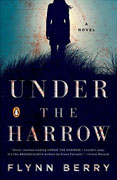Under the Harrow
Flynn Berry
book reviews:
· general fiction
· chick lit/romance
· sci-fi/fantasy
· graphic novels
· nonfiction
· audio books
· author interviews
· children's books @
curledupkids.com
· DVD reviews @
curledupdvd.com
newsletter
win books
buy online
links
home
for authors
& publishers
for reviewers

 |
Under the Harrow Flynn Berry Penguin Books Paperback 240 pages June 2016 |
|
An isolated house in the country, a mysteriously dead sister, and the haunting feeling that someone is looming over her. Nora, the first-person narrator of Berryís first novel, is traveling on the train from London to the village of Marlow, to the home of her beloved sister, Rachel. Nora tells us about a woman who has gone missing in East Riding, an area near where the sisters grew up. When Rachel learns of the womanís disappearance, she thinks it is the man who brutally attacked her in Snaith fifteen years ago. Although no one was ever arrested for the crime, the sisters have never stopped looking for the perpetrator.
From her past actions, to her work as a registered nurse, to her refusal to marry her ex-boyfriend, Stephen Bailey, Rachel left her mark on everything and everyone who knew her. As the secrets behind Rachelís demise come to light and as her memories link together, Nora finds herself endlessly tormented by what her sister wanted to tell her. As the investigation gets underway, along with the usual details that involve the building of a complicated case, the first person to come under suspicion is Rachelís neighbor, the plumber Keith Denton. Keith was at Rachelís house that day, he doesnít have an alibi, yet he confesses to the police that he really liked her. An intensive search of the area surrounding Rachelís house begins, encompassing the rim of the woods where a stalker was reportedly last seen. Nora meanwhile, finds herself plagued with images of the crime scene: Rachelís dead dog rotating from the ceiling; her sister lying curled to the wall; the red handprints on the stairs; and Rachelís last text to her saying she was going to meet someone called Martin, a friend from the hospital. Although all the evidence points to Keith Dentonís guilt, Moretti is adamant that they donít have grounds to arrest him. Considering Rachelís checkered past, Nora worries about the implications for the investigation, asking DI Lewis, Morettiís partner, to say nothing while promising him to remain objective. More complications arrive with the introduction of yet another suspect: Andrew Healy, who two years ago assaulted a teenage girl in Whitley. Moretti tells Nora that in the weeks before she was killed, Rachel had visited Healy in a high-security prison just outside of Bristol. As Noraís sense of anxiety increases, she begins to paint a very different picture of the type of girl her sister was: a sometimes violent individual, prone to sudden outbursts of temper, whose relationships with those around her were sometimes shrouded in difficulty. Most of the narrative is spent building up Noraís unending sense of anxiety and inferiority
while the author carefully moves us from one shady suspect to the next. Nora remains a prisoner of her grief, an anguish that subtly plays out within Berryís eerie and bucolic English landscapes. Sinister, subversive, and haunting, Under the Harrow Unfolding Noraís plight in short, sharp chapters, Berry writes with the self-confidence of a veteran author. Steadily unfolding Noraís ominous and dangerous obsession with Keith Denton, Berry balances all of Noraís pain and loss and heartbreak against the pervading sense of anticipation that she will eventually--albeit at a more calculated pace--discover the identity of her sisterís killer. Originally published on Curled Up With A Good Book at www.curledup.com. © Michael Leonard, 2016 |
| Also by Flynn Berry: |
|
|
|
 Click here to learn more about this month's sponsor! |
|
| fiction · sf/f · comic books · nonfiction · audio newsletter · free book contest · buy books online review index · links · · authors & publishers reviewers |
|
| site by ELBO Computing Resources, Inc. | |
 Nora knows something is terribly wrong from the moment she finally arrives at Rachelís house. Rachelís body
lies turned to the ceiling with her dark hair pooling on the floor and her arms placed at her sides. Beyond the presence of patrol cars and the police in black uniforms, the edges of Noraís vision begin ďto go soft with grief.Ē She tells DI Moretti, the first detective to arrive at the scene, that Rachel hadnít been herself lately; she seemed frayed and was always tired.
Nora knows something is terribly wrong from the moment she finally arrives at Rachelís house. Rachelís body
lies turned to the ceiling with her dark hair pooling on the floor and her arms placed at her sides. Beyond the presence of patrol cars and the police in black uniforms, the edges of Noraís vision begin ďto go soft with grief.Ē She tells DI Moretti, the first detective to arrive at the scene, that Rachel hadnít been herself lately; she seemed frayed and was always tired.